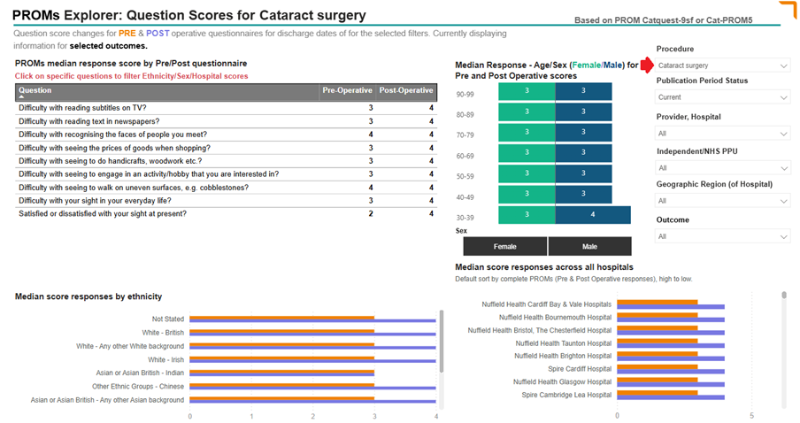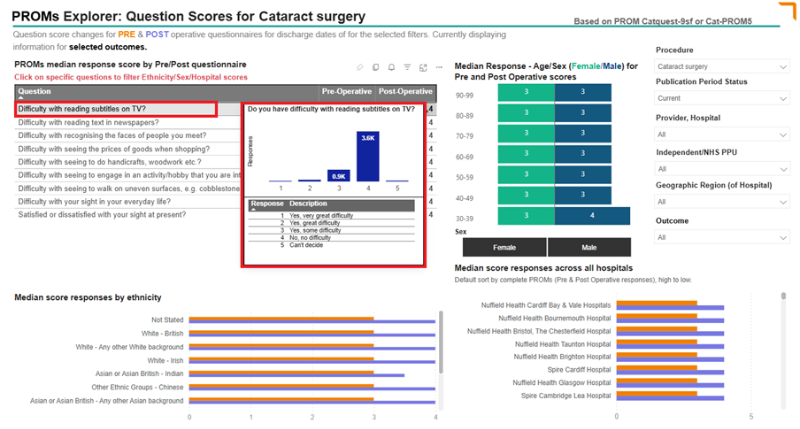We want to know whether medical treatments are effective, so we ask patients a set of questions before treatment and then the same questions after it to see how factors such as pain, quality of life, function have been affected. For example you may have a knee replacement because you suffer long-term pain, and hope that once you have recovered from the surgery you will experience less pain and can move around more easily.
What are Patient-Reported Outcome Measures (PROMs)?
PROMs are the result of patients taking the time to share their experiences by completing questionnaires before and after their treatment. They do this to help future patients better understand whether they need treatment and what their experiences might be.
The value of the PROMs is that it can show how patients typically are before treatment and after treatment, to help manage a sense of suitability for treatment as well as expectations after it.
The 'after' questions are asked several months after surgery, usually between two to six months, depending on the type of treatment, so that the patient has had sufficient time to recover and feel the expected full benefits.
What does the Explorer show?
PHIN has brought together data from thousands of private patients who have completed PROMs for six types of surgery:
- Knee replacement
- Hip replacement
- Cataract surgery
- Breast augmentation
- Liposuction
- Rhinoplasty
We are publishing these results on the PROMs Explorer so that you can understand how people are before treatment – to help with questions you may have like ‘Are my symptoms normal for someone before cataract surgery?’ – and then to gain a sense of how that treatment might affect you.
Can I see results for patients like me?
The results can be filtered on the tool so that you can see any reported differences by age groups, genders, ethnicities and geographical regions, which might be helpful if you’re wanting to consider the impact for someone more like yourself.
Note that these are average scores collected for many patients. No surgery is 100% guaranteed for success for all patients; in rare cases, some patients can get worse after treatment. This tool is designed to give you more realistic and tangible expectations about the likely effects for these six surgical interventions.
Where there is sufficient data, you can use the tool to filter results even down to a hospital level. However PHIN, like the NHS, does not report data where there are very low numbers of patients (below eight), to avoid any risk of identifying individuals.
Tell me how it works, and what else I can see?
Imagine for example that you’re thinking about having cataract surgery – it’s the most common surgery in private healthcare.
Using the ‘Outcomes – Responses’ tab on the dashboard, select ‘Cataract surgery’ (see red arrow below) as the Procedure at the top right of the screen. For now, leave the other options below ‘Procedure’ unchanged.

The various questions for patients having cataract surgery are listed on the left hand side of the screen. Patients give their scores to the questions both before treatment (“Pre-operative”) and then after treatment (“Post-operative”).
In this example for cataracts, the first question asked is whether patients have had ‘Difficulty with reading subtitles on TV?’ If you now hover above the corresponding average scores, for example the number 3, an additional graph should appear on your screen showing the numerical scale, the distribution of responses and what the scores mean.
With this example, most patients score 3 on a scale of 1 to 5. The score description shows how this means that most patients have some difficulty reading the subtitles before their treatment.
After treatment, most patients now report that they have no difficulty reading subtitles – see the red box in the illustration below and the larger bar chart to its right. For these patients, in this respect their cataract surgery has been effective.

The same process applies for other detailed questions related to cataracts. Each surgery has its own questionnaire and so the questions, as well as potentially the scales, will vary, but the before / after approach remains the same.
How is this useful to me?
The questions can be useful to you to think about potential factors you might want to consider before having surgery, and topics you might want to talk about with your surgeon.
The questions and results might also be useful to consider after surgery. Note that most after-treatment questionnaires are asked between three and six months. You may be wondering, ‘Am I recovering like other people – is this normal?’ The evidence may be reassuring – or a reason to contact your surgeon if after several months you are not recovering in a similar way.
What about the other filters on the right-hand side of the screen, including hospitals and outcomes?
As well as choosing the procedure, there are several other selections you can make based on the filters on the right-hand side of the screen. These options include:
- Current or Previous period: This indicates more or less recent data. Some hospitals have only started submitting this data to PHIN more recently than others.
- Provider, Hospital: Some hospitals belong to much larger groups (Providers). You can select results for the individual hospital site, or results for the overall group (e.g. Circle Health Group), or multiple combinations of hospitals and groups.
- Independent / NHS PPU: We collect our data both from independent private hospitals as well as for NHS hospitals that have dedicated private patient units (PPUs).
- Geographic Region (of Hospital): You can also look at results from any one or selection of the 10 main geographic regions in the UK, including Scotland, Wales and Northern Ireland.
- Outcome: You can choose to focus only on patients whose aggregate score represents an improvement, no change or a worsening of their health related to their procedure. This may be of interest when comparing different results for e.g. different hospitals, different regions or age groups.
Further questions
Please do not hesitate to contact patients@phin.org.uk if you have any feedback or questions on the PROMs Explorer. This is a new tool and we would welcome your thoughts as we seek to improve it.
You can also find out more about your surgical procedure using this link: PHIN - Help and advice.
The PROMs Explorer
Go to the PROMs Explorer
